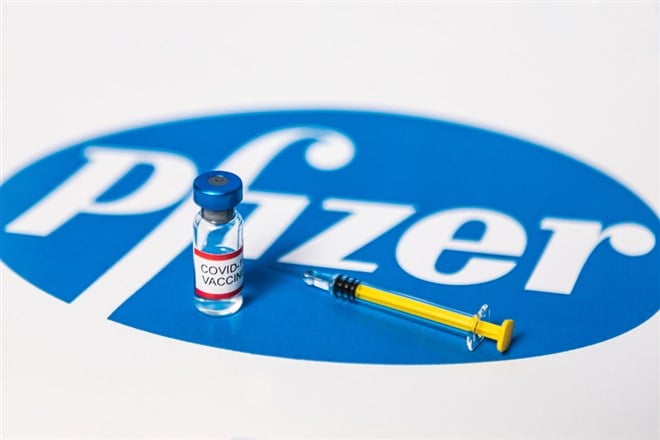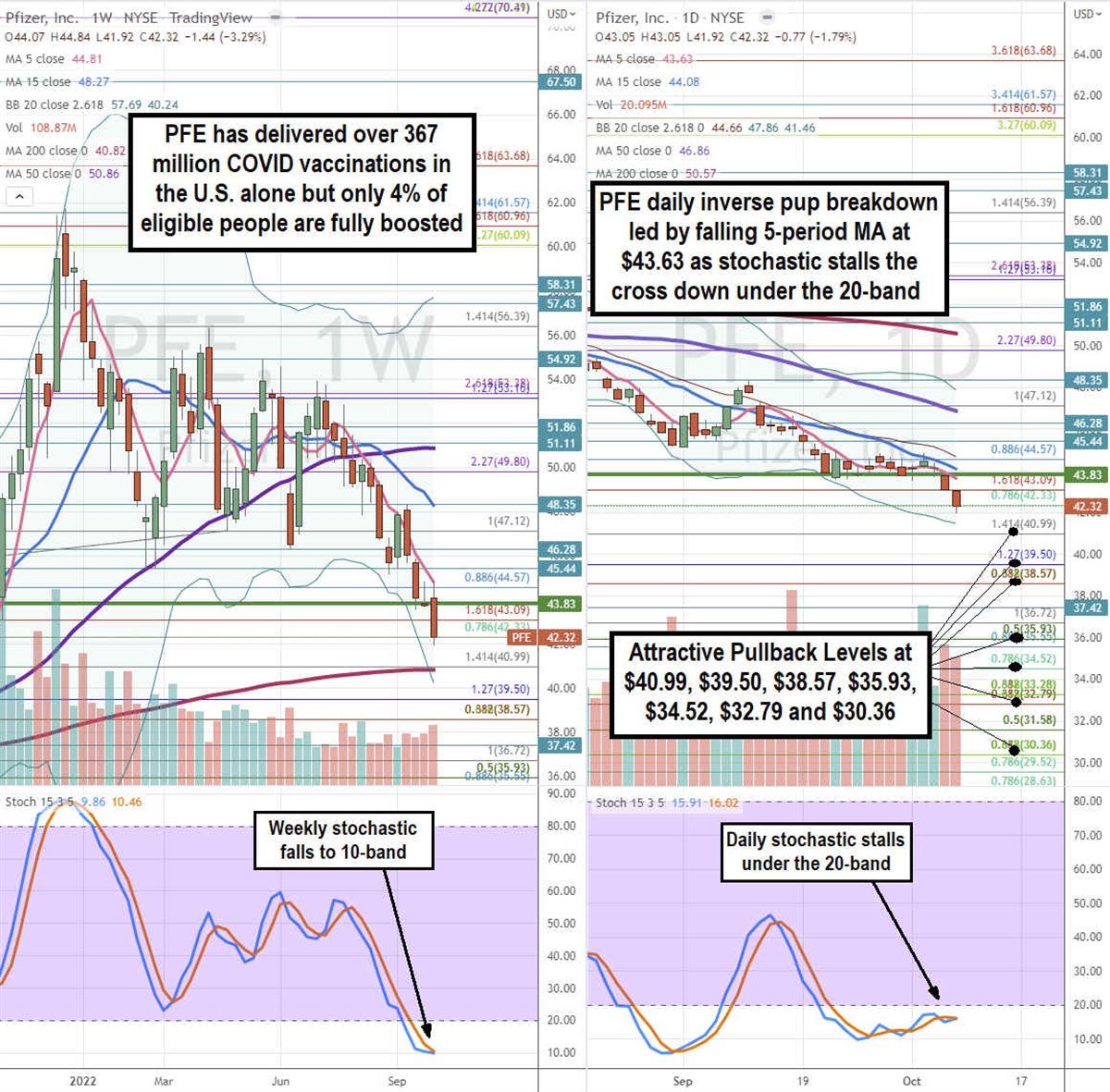 Literally synonymous with COVID-19 vaccines, pharmaceutical giant Pfizer Inc. (NYSE: PFE) has delivered over 367 million vaccinations in the U.S. alone and over 1.4 billion does worldwide since the pandemic began.
Literally synonymous with COVID-19 vaccines, pharmaceutical giant Pfizer Inc. (NYSE: PFE) has delivered over 367 million vaccinations in the U.S. alone and over 1.4 billion does worldwide since the pandemic began. Moderna Inc. (NASDAQ: MRNA) comes in a distant second place with over 230 million vaccinations. Johnson & Johnson (NYSE: JNJ) comes in a telescopic third place with a distribution of just over 2.5 million COVID-19 vaccinations. Novavax Inc. (NASDAQ: NVAX) administered just over 30,000 vaccinations in the U.S. There’s no disputing that the pandemic has been a boon to Pfizer’s top and bottom lines and helped it expand its mRNA technology. The U.S. Department of Health and Human Services (HHS) stated in a report released October 6 that vaccinations were responsible for preventing over 600,000 hospitalizations and 300,000 deaths among Medicare patients. However, as the pandemic becomes less of a focus, investors wonder if Pfizer stock's good times will also follow suit.
Bustling COVID-19 Franchise
Pfizer and its partner BioNTech (NASDAQ: BNTX) have turned COVID vaccinations into an evergreen franchise business with its booster shots — only 4% of eligible people are fully boosted. While some investors may see this as a glass-half-full situation and believe 96% more booster vaccinations will unleash, the general population may be getting complacent. More individuals drop off with each round of booster shots, which naturally hurts Pfizer’s bottom line.
Paxlovid Drives Growth
Pfizer continues to develop COVID-19 therapies for the COVID franchise, including Paxlovid, an oral pill that fights the virus by preventing it from replicating in the body. It’s a three-pill antiviral regimen for people who contract COVID-19 and treats those in higher-risk categories (the elderly, diabetics, heart and kidney disease and cancer patients). It has been proven 89% effective in cutting hospitalizations and death compared to a placebo group. President Joe Biden was the most high-profile candidate to use the drug. Some patients, like Biden, experience “Paxlovid rebound,” where he tested positive for COVID-19 again, but without symptoms. This occurs in 1% to 2% of patients but outcomes are still positive.
The company expects Paxlovid to generate $22 billion and Comirnaty (a COVID-19 vaccine for immunization) to generate $32 billion over last months of 2022. Pfizer inked a $3.2 billion deal with the U.S. government for the fall vaccination campaign.
Expanding mRNA
Pfizer and BioNTech have expanded the applications for its mRNA vaccines to include influenza (flu) and shingles. The global influenza market is estimated to exceed $10 billion by 2030. Pfizer has already formed a 25,000-subject test group for its third phase quadrivalent mRNA vaccine for the flu. Its expanded Acuitas Therapeutics lipid nanoparticles (LNP) licensing enables Pfizer to target vaccines for 10 other indications. It also acquired Biohaven Pharmaceuticals for $3.5 billion to gain its migraine drug Nurtec ODT and zavegepant.
Pfizer has a robust pipeline of over 90 drugs in development and 12 pivotal readouts for 2022. Two drugs with billion-dollar potential in phase three include its Duchenne syndrome (250,000 patients globally) and respiratory syncytial virus ($4 billion market by 2027). However, competitors Sarepta (NASDAQ: SRPT) and GlaxoSmithKline (NYSE: GSK) are both further ahead in development.

PFE Opportunistic Pullback Levels
Using the rifle charts on the weekly and daily timeframes provides a precision view of the landscape for PFE stock. The weekly rifle chart has been in a sharp downtrend led by the five-period moving average (MA) resistance at $44.81, followed by the 15-period MA resistance at $48.27 and falling through the weekly market structure low (MSL) buy at $43.83. The weekly 200-period MA support sits near the $40.99 Fibonacci (fib) level. The weekly 200-period MA support lies at $40.82 and weekly lower Bollinger Bands (BBs) at $40.24. The weekly stochastic formed a bearish mini inverse pup that dropped it through the 10-band. The daily rifle chart formed an inverse pup breakdown with a falling five-period MA resistance at $43.63 followed by the daily 15-period MA at $44.08. The daily lower BBs sit at $41.46. Attractive pullback levels sit at the $40.99 and weekly 200-period MA, $39.50 fib, $38.57 fib, $35.93 fib, $34.52 fib, $32.79 fib and the $30.36 fib level.
Earnings Still Blowing Up
On July 28, Pfizer released its fiscal Q2 results for the quarter ending June 2022. The company reported an earnings per share (EPS) profit of $2.04 versus $1.78 consensus analyst estimates, a $0.26 beat. The company saw revenues grow 46.8% year-over-year (YoY) to $27.74 billion, driven by Paxlovid and Comirnaty and beating analyst estimates for $26.2 billion.
Raised Lowered Guidance for 2022
Pfizer has raised the lower end of its earlier lowered full-year 2022 estimates by $0.05 for EPS coming in between $6.30 to $6.45 versus $6.67 consensus analyst estimates. Full-year 2022 revenues should come in between $98 billion to $102 billion versus $103.62 billion per consensus analyst estimates. Based on supply contracts, the company expected $32 billion in sales for Comirnaty and $22 billion in revenues for Paxlovid.

